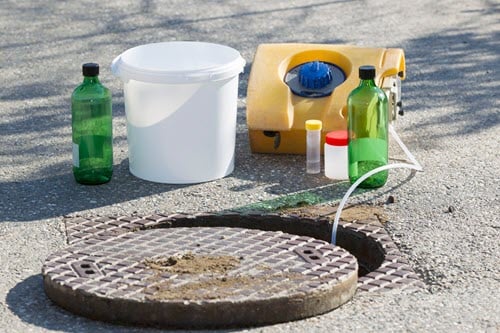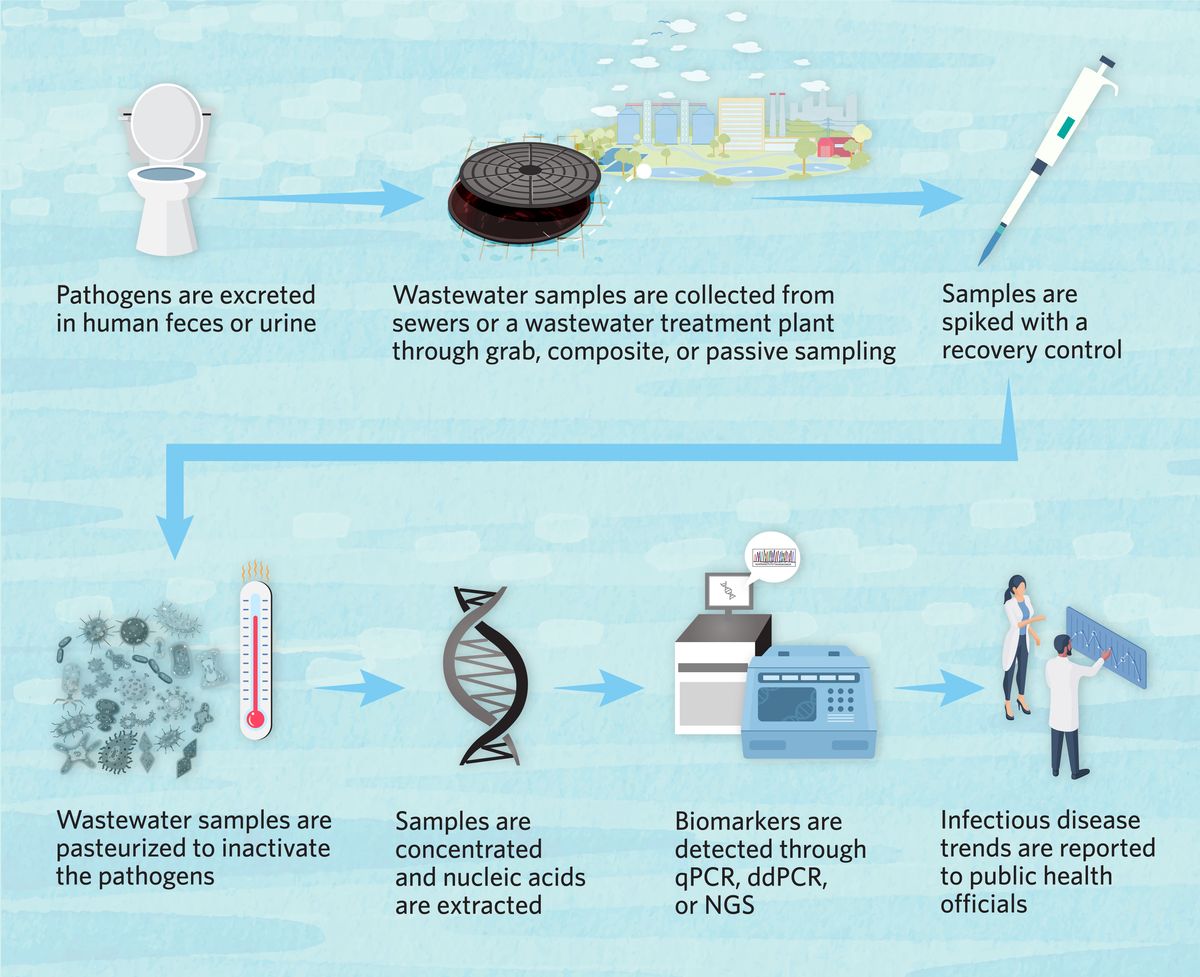
Article reviewed by Robert Delatolla, PhD, PEng, from the University of Ottawa.
Stay up to date on the latest science with Brush Up Summaries.
What Is Wastewater Surveillance?
Wastewater surveillance, which is also called wastewater-based surveillance or wastewater-based epidemiology, is the process of monitoring the prevalence of biological and chemical markers within a population by analyzing wastewater.1 Scientists use this tool for various applications including tracking disease occurrence and illicit or pharmaceutical drug use, where this article will focus only on disease surveillance. Researchers collect sewage samples, which contain human urine and feces, from wastewater treatment plants or sewer lines to molecularly assess the abundance and diversity of disease biomarkers within human waste. This testing informs public health officials about disease trends in their communities.2
How Is Wastewater Used to Monitor the Health of a Community?
Historically, public health officials have employed wastewater-based epidemiology to track infectious disease transmission in a population, as some infectious agents are shed in the urine or feces of infected patients. Researchers have also proposed that they could use wastewater-based surveillance to examine the prevalence of chronic diseases within a community.
Table 1: Examples of infectious diseases that researchers monitor through wastewater surveillance and chronic diseases that may be detectable in wastewater.
| Disease | Infectious Agent or Biomarker |
Previous Detection in Wastewater | Polio3,4 | |
Covid5,6 | ||
Influenza viruses | ||
Noroviruses | ||
Mpox9 | Mpox virus | |
RSV | ||
Campylobacter spp. | ||
Candida auris | ||
Cryptosporidium spp. | ||
Expected Detection in Wastewater | Normetanephrine | |
α-fetoprotein | ||
Microtubule assisted serine/threonine kinase 4 (MAST4) | ||
Cardiac troponin I (cTnI), cystatin C |
Detecting infectious diseases
In 1939, scientists detected live poliovirus within wastewater during a polio (also known as poliomyelitis) epidemic.3 However, they were unable to detect these viral particles after the epidemic ended.4 They hypothesized that researchers could use wastewater testing to track infection levels within a population. At first, scientists cultured the live infectious agents or used the samples to infect animal models to measure infectious diseases. Researchers now assess the levels of emerging and re-emerging viral, bacterial, protozoan, and fungal pathogens by detecting their nucleic acids.
Wastewater surveillance rapidly increased in popularity during the covid pandemic, as researchers detect SARS-CoV-2 in the feces and urine of infected patients before the onset of symptoms.5 The Centers for Disease Control and Prevention (CDC) started the National Wastewater Surveillance System (NWSS) to assess SARS-CoV-2 levels in wastewater collected across the United States.15 Through wastewater-based epidemiology, scientists estimate the prevalence of covid in communities and identify new variants.6 Additionally, wastewater analysis provides public health officials with information about potentially unreported cases. Besides polio and covid, researchers have also used wastewater-based surveillance to track the transmission of influenza, norovirus, mpox, respiratory syncytial virus (RSV), campylobacteriosis, Candida auris, and cryptosporidiosis.7–13
Detecting chronic diseases
Patients suffering from chronic diseases, such as cancer and cardiovascular disease, release disease-specific protein biomarkers through their urine.14 Because of the success of tracking infectious diseases, researchers have suggested that wastewater-based epidemiology could also be employed to track the prevalence of chronic diseases. To aid in the future application of this tool, they have begun identifying potential protein biomarkers to detect cancer and cardiovascular disease in wastewater, including normetanephrine for catecholamine-secreting tumors, α-fetoprotein for prostate and liver cancer, microtubule assisted serine/threonine kinase 4 (MAST4) for breast cancer, cardiac troponin I (cTnI) for myocardial infarctions or heart failure, and cystatin C for atherosclerosis.14 However, this will require scientists to establish mass spectrometry-based protocols for these protein biomarkers.16
How Is Wastewater Tested?
To examine infectious disease trends through wastewater surveillance, researchers first collect wastewater samples, extract DNA or RNA, and finally analyze the nucleic acids through PCR or sequencing.

Wastewater sampling methods
Researchers collect untreated wastewater or primary sludge samples, which they gather after the first sedimentation, using three methods: grab sampling, composite sampling, or passive sampling.17 A grab sample is a single aliquot of wastewater that gives researchers a snapshot at a single moment in time.18 Grab sampling is a rapid process, but fluctuations in the flow rate or the wastewater composition can negatively affect the results. A composite sample is composed of multiple grab samples collected over a period of time and pooled together.18 However, composite sampling is usually performed by expensive automated samplers, which can limit its application in some communities. Researchers obtain a passive sample by submerging an absorbent sampler into the wastewater and allowing the infectious agent or disease biomarker to passively enter the sampler over time.19 Passive sampling is cheap to employ and collects analytes over time, but collisions with solids in the wastewater can damage the samplers.
Preparing samples for nucleic acid extraction
Raw wastewater is a complex chemical and biological mixture, which contains components that can hinder nucleic acid recovery and disease biomarker quantification.20 Additionally, biomarker concentrations in large volumes of wastewater often fall below the detection limit.21 Consequently, researchers must purify and concentrate nucleic acid extracts.
After the wastewater samples arrive in the laboratory, scientists spike their samples with a known concentration of a surrogate microbe, such as murine hepatitis virus or bovine respiratory syncytial virus.22 This recovery control enables them to determine the amount of sample lost through processing. Additionally, researchers can heat pasteurize the wastewater samples to reduce the risk of aerosolized pathogens, but this can reduce nucleic acid recovery from samples that originate from small populations.23 After heat inactivation, scientists remove the large solids through filtration or centrifugation and concentrate the samples through various techniques, including ultrafiltration, precipitation, or ultracentrifugation.21 Nucleic acids are then isolated and purified using manual or automated extraction kits.
Analyzing nucleic acids with PCR and NGS
Scientists commonly use quantitative PCR (qPCR) to detect and quantify DNA biomarkers within wastewater samples and RT-PCR which includes a reverse transcription step to analyze RNA by qPCR.24 However, researchers have suggested that droplet digital PCR (ddPCR) is better suited to wastewater-based surveillance, as the technique is more tolerant to inhibitors and it is highly sensitive. Additionally, ddPCR allows scientists to detect the absolute biomarker quantity without a standard curve.25 Regardless of the PCR technique used, researchers must normalize their disease biomarker quantifications to the total amount of human waste within the sewage sample. This is commonly accomplished by measuring the quantity of a control organism found regularly within feces or urine, such as cross-assembly phage or pepper mild mottle virus.26 In addition to PCR-based methods, researchers can also perform next-generation sequencing (NGS) on their wastewater samples to identify new microbe variants that are circulating within the population.27

References
1. O’Keeffe J. Wastewater-based epidemiology: current uses and future opportunities as a public health surveillance tool. Environ Health Rev. 2021;64(3):44-52.
2. Diamond MB, et al. Wastewater surveillance of pathogens can inform public health responses. Nat Med. 2022;28(10):1992-1995.
3. Paul JR, et al. Poliomyelitic virus in sewage. Science. 1939;90(2333):258-259.
4. Trask JD, Paul JR. Periodic examination of sewage for the virus of poliomyelitis. J Exp Med. 1942;75(1):1-6.
5. Shah S, et al. Wastewater surveillance to infer COVID-19 transmission: A systematic review. Sci Total Environ. 2022;804:150060.
6. Child HT, et al. Optimised protocol for monitoring SARS-CoV-2 in wastewater using reverse complement PCR-based whole-genome sequencing. PLOS ONE. 2023;18(4):e0284211.
7. Vo V, et al. Identification and genome sequencing of an influenza H3N2 variant in wastewater from elementary schools during a surge of influenza A cases in Las Vegas, Nevada. Sci Total Environ. 2023;872:162058.
8. Oh C, et al. Improved performance of nucleic acid-based assays for genetically diverse norovirus surveillance. Appl Environ Microbiol. 2023;89(10):e00331-23.
9. de Jonge EF, et al. The detection of monkeypox virus DNA in wastewater samples in the Netherlands. Sci Total Environ. 2022;852:158265.
10. Mercier E, et al. Wastewater-based surveillance identifies start to the pediatric respiratory syncytial virus season in two cities in Ontario, Canada. Front Public Health. 2023;11.
11. Zhang S, et al. Wastewater-based epidemiology of Campylobacter spp.: A systematic review and meta-analysis of influent, effluent, and removal of wastewater treatment plants. Sci Total Environ. 2023;903:166410.
12. Barber C, et al. Community-scale wastewater surveillance of Candida auris during an ongoing outbreak in Southern Nevada. Environ Sci Technol. 2023;57(4):1755-1763.
13. Zahedi A, et al. Profiling the diversity of Cryptosporidium species and genotypes in wastewater treatment plants in Australia using next generation sequencing. Sci Total Environ. 2018;644:635-648.
14. Amin V, et al. Systematic scoping review evaluating the potential of wastewater-based epidemiology for monitoring cardiovascular disease and cancer. Sci Total Environ. 2023;858(Pt 3):160103.
15. CDC. National Wastewater Surveillance System. Centers for Disease Control and Prevention. Last Reviewed March 14, 2023. Accessed December 20, 2023.
16. Picó Y, Barceló D. Mass spectrometry in wastewater-based epidemiology for the determination of small and large molecules as biomarkers of exposure: toward a global view of environment and human health under the COVID-19 outbreak. ACS Omega. 2021;6(46):30865-30872.
17. Hrudey SE, et al. Wastewater surveillance for SARS-CoV-2 RNA in Canada. FACETS. 2022;7:1493-1597.
18. Augusto MR, et al. Sampling strategies for wastewater surveillance: Evaluating the variability of SARS-COV-2 RNA concentration in composite and grab samples. J Environ Chem Eng. 2022;10(3):107478.
19. Wilson M, et al. Comparison of auto sampling and passive sampling methods for SARS-CoV-2 detection in wastewater. Pathog Basel Switz. 2022;11(3):359.
20. Aguayo-Acosta A, et al. Passive sampler technology for viral detection in wastewater-based surveillance: current state and nanomaterial opportunities. Viruses. 2023;15(9):1941.
21. Kabdaşli I, Tünay O. Concentration techniques tailored for the detection of SARS-CoV-2 genetic material in domestic wastewater and treatment plant sludge: A review. J Environ Chem Eng. 2021;9(5):106296.
22. Kumblathan T, et al. Wastewater-based epidemiology for community monitoring of SARS-CoV-2: Progress and challenges. ACS Environ Au. 2021;1(1):18-31.
23. Beattie RE, et al. Evaluating the impact of sample storage, handling, and technical ability on the decay and recovery of SARS-CoV-2 in wastewater. PLOS ONE. 2022;17(6):e0270659.
24. Kallem P, et al. SARS-CoV-2 detection and inactivation in water and wastewater: review on analytical methods, limitations and future research recommendations. Emerg Microbes Infect. 2023;12(2):2222850.
25. The dMIQE Group, Huggett JF. The digital MIQE guidelines update: Minimum information for publication of quantitative digital PCR experiments for 2020. Clin Chem. 2020;66(8):1012-1029.
26. Mazumder P, et al. Sewage surveillance for SARS-CoV-2: Molecular detection, quantification, and normalization factors. Curr Opin Environ Sci Health. 2022;28:100363.
27. Itarte M, et al. Looking for a needle in a haystack. SARS-CoV-2 variant characterization in sewage. Curr Opin Environ Sci Health. 2021;24:100308.


